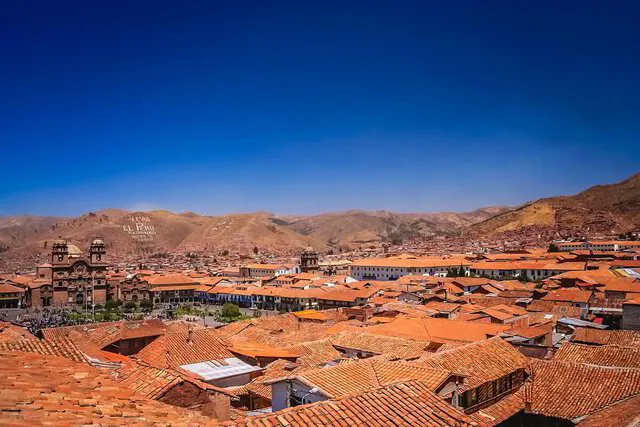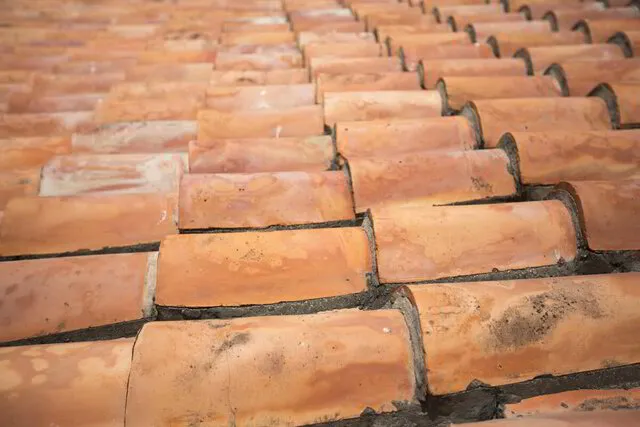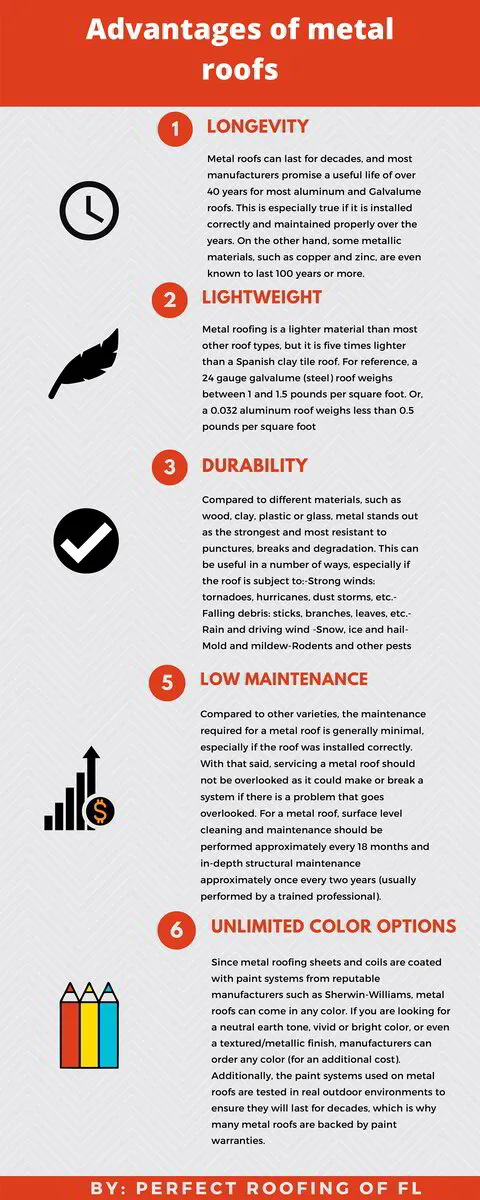Metal Roofs Versus Spanish Clay Tiles: Which Roofing Material Is Better?
Understand the pros and cons of each of these roofing materials. We want you to be informed and choose the best option for you and for your home. Our hope is that with greater understanding, you will have a better experience with us.
The question we are always asked is: what is the best roofing material? Our answer: it depends.
While our main product category at Perfect Roofing of Florida is metal roofing, we understand that metal roofing is not suitable for every home or building. That's why we do our best to educate buyers with unbiased data on the various material options out there.
In this article, you’ll learn:
- Advantages and disadvantages of Spanish tiles.
- Advantages and disadvantages of metal roofs.
- Analysis of different factors to consider before making a purchase
Advantages:
Longevity - One of the most important reasons home and property owners install a Spanish tile roof is that it has been proven option for decades. There have been cases where a well-cared-for roof can last more than 100 years.
Reduced Heat Transfer - Tile roof is one of the preferred materials if you live in an area where heat transfer to a building can be an issue. According to the Tile Roofing Industry Alliance, "Roofing tiles have a natural thermal resistance in the raw materials themselves that are created by the larger cross-sectional areas of the tiles while they are installed." How they are installed individually causes the heat to be transferred from one place to another. This allows the building's interior temperatures to stay cooler in the summer and warmer in the winter.
Colonial aesthetics: Spanish clay tiles have terracotta colors with earthy brown and rustic red tones. You will notice that the majority of buildings with Spanish clay tiles are concentrated in certain areas of the United States. They are located in areas of the Mediterranean and Spanish architectural influences popular in places like Florida, Georgia, the Southwest, and Southern California.
Environmentally-friendly: As mentioned, most tile roofs are made of clay (or terracotta clay), a regenerative natural element found in the earth. Consequently, there is no use of chemicals. Additionally, Spanish tiles can be easily recycled and reused for future items.
Less maintenance: Spanish tiles do not require frequent maintenance. For the most proactive approach, it is recommended that Spanish tiles be inspected once or twice per year (by a professional) to look for:
-Leaks and water damage
-Leaves, branches, and other debris
-Cracked or damaged roofs
-Birds and other animals
Fortunately, if there are one or more shingles that need to be replaced, you don't need to damage an entire section of your roof. Broken Spanish tiles can be removed and replaced relatively easily.
High Fire Resistance - Like metal roofs, clay tiles often have a Class A fire rating (UL 790 - Standard Test Methods for Roof Covering Fire Testing), which means it is less likely to burn or catch fire.
Disadvantages of Spanish clay tiles:
Brittle: They break or chip easily when applying force.
Heavy - Clay tiles are some of the heaviest materials you can install on your roof. Depending on the style and size, Spanish clay tiles can weigh between 8 and 15 pounds per square foot.
Strict slope requirements: To drain water properly, the absolute minimum slope is 2.5 / 12. For a 2.5 / 12 through 4/12 pitched roof, it is recommended that you use two layers of subfloor to ensure that water does not leak in. For slopes 4.5 and higher - considered steep slopes for clay tile - only one layer of underlayment is needed.
Limited Colors: Spanish tiles are best known for their reddish-orange color and are made of clay or terracotta. While the red/orange color fits some architectural aspects, it is not suitable for all buildings or owners, which may or may not be inconvenient. However, special colors are available upon request, including: blue, green, black or white. Keep in mind these can be more expensive.
OUR STORY
Advantages of metal roofs
Other advantages
High Fire Resistance
Metal roofs are typically Class A fire rated and non-combustible, making them the most fire-resistant. This is important in wildfire-prone regions because if hot ashes or embers fall on the surface of a metal roof, it has the greatest potential to NOT catch fire.
Highly Recyclable
Metal roofs are 100% recyclable, so old or unused panels, detached metal, and leftover waste can be recycled for use in future products. In addition, some coils and sheets used to make metal roof panels may contain previously recycled metals. For reference, metal roofing materials can be either pre-consumer or post-consumer recycled:
- Pre-consumer recycled materials - Scrap content produced during the manufacturing stage that has been recycled for future use.
- Post-consumer recycled materials: excess materials that have already been used by a consumer at a certain time and that have been recycled for reuse.
Low Slope Capability
Metal roofs are less stringent when it comes to minimum slope requirements, but are still dependent on the type of profile being used. For example, snap shut systems should only be installed on roof pitches 3/12 and higher unless otherwise approved by the manufacturer. On the other hand, mechanically seamed double-lock metal roof systems are suitable for low slope applications:
- 2’’ Double Locking Profile - Can often be installed up to 5 / 12 pitch with sealant at joints (depending on location).
- 1.5’’ Double Locking Profile - Can often be installed in 1/12 pitch with sealant at joints (depending on location).
Disadvantages of metal roofs
Cost: generally costs range from medium to high. Though metal roofs are less expensive than tile roofs, they are not an economical option. The price of a metal roof varies depending on where you live, the profile you choose, the color, and a host of other considerations. The average cost of a raised seam metal roof system ranges from $7 to $12 per square foot.
Qualified installers needed: -There are not many trained professionals who know how to install roofs in the area. Fortunately, at Perfect Roofing, we do! This type of roof requires attention to detail and not everyone has the necessary expertise when it comes to installation.
Aesthetic restrictions: there are communities, homeowners associations, and historic districts that do not allow the installation of metal roofs on properties within their jurisdiction, as they consider that it damages the aesthetics of the area.
Oil Canning: Oil canning is an inherent characteristic of light-gauge cold-rolled flat metal products and is described as the perceived waviness in the wide, flat areas of metal panels. While oil canning is just a cosmetic issue and will not affect the integrity of the roof system, some home and property owners see it as unpleasant. Fortunately, there are methods to reduce the likelihood of the occurrence of oil canning.
What to consider before buying a metal roof vs. a tile roof
Budget : Both metal roofs and tile roofs are premium roofing materials. Even so, there is a price difference, as metal roofs will be less expensive. But if you are in a situation where you can splurge on a more expensive roof, Spanish shingles may be right for you.
Location and surroundings: There are different locations throughout the country where certain types of roofs are most prevalent due to the architectural theme of the region. For example, you won't find many Spanish tile roofs in New York or Colorado. But if you go to California or Florida, you will see tiles everywhere. On the other hand, metal roofs are common throughout most of the United States, especially in mountainous and coastal environments.
Your style: When deciding between metal and tile roofs, it is important to know the style you are looking for. These two materials look very different; metal roofs tend to be a bit more modern and stylish while tiles are more traditional and colonial.
First of all, start with these questions for yourself:
- -How much money am I comfortable with spending on a roof?
- -Are there trained and qualified contractors installing these materials at my location?
- -What roofing material is popular in other buildings or homes around me?
- -What colors will look good on my roof? What colors do I personally like?
- -What legislation is restricted against different types of roofs?
- -Will my building structure support a heavier roofing system?
With more than 20 years of installing metal roofing products, Perfect Roofing of Florida knows that it is not always an easy decision to make on your own. Whether you want to purchase a metal roof with vertical joints, a Spanish tile roof, a tile roof or otherwise, we are here to ensure that you choose the roof that best suits your needs.
Always contact the best roofing company in Miami!
Any Questions or Concerns?
CONTACT US TODAY!
*Only for Home Owners. / *Solo para Dueños de Casa.
*We are NOT Hiring. / *NO estamos Contratando.






